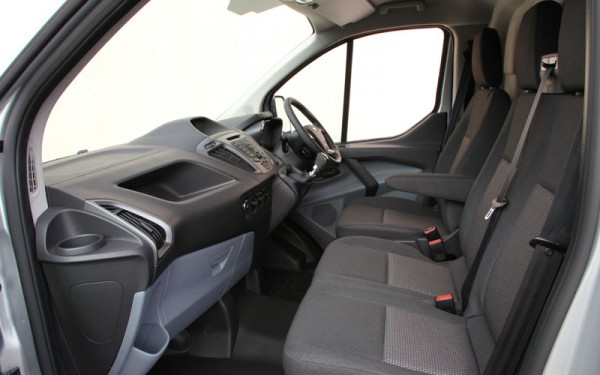
Loads of nice touches, like a ‘desk’ that pulls down from the back of the middle seat, and whopping great 2 litre bottle holders
What’s hot
- You may be tempted to assume that with all this weirdy-beardy environmental gubbins on board, this van would be as dull as ditchwater to drive and about as perky as a slug on valium.
- Well, you’d be wrong. We took this little beauty (yes it looks great too!) out for a spin on the highways and byways of Essex with a half load on board and to be honest we couldn’t tell a whole lot of difference between it and its conventional brother.
- There’s 100bhp on offer, which is the lowest power output offered in the range, but thanks to torque coming at in at low 1300rpm this engine feels faster than it really is.
- I’d have to hold my hands up and admit that I wasn’t aware of the Acceleration Control unit until Ford bosses mentioned it after my drive. That just shows how good the system is.
- There are some nice touches in the cab too, such as a little desk that pulls down from the back of the middle seat and a 12-volt take off on top of the dash, which means that if you plug in a sat nav you won’t end up with wires trailing across the van. Top marks too for the two-litre cola bottle bins on each side of the cab and the nice big rearview mirrors.
- In the back there are six cubic metres of cargo space, which is more than was on offer from the old Transit of this weight, and there are no fewer than eight load-lashing eyes.
- The big questions is this: is it worth paying £226 more for this model over the non-eco Trend equivalent? And the answer is yes, as we reckon that at 2mpg better fuel economy you’ll save around £522 in fuel over an 80,000-mile lifecycle. You can also drive around smugly pointing out to clients the ECOnetic badge on the back of your van which says you are doing your bit to help save the earth.
What’s not
- We hold this van in such high regard that any criticisms are niggling in the extreme – such as the fact that the heater and aircon controls are tucked away behind the gearlever and are rather difficult to get at while driving.
- But the main problem we have with this vehicle – and indeed all others like it – is that all these fuel economy figures are calibrated with the vehicles empty and on a rolling road in a nice warm shed. Hence they don’t take into account any loads you may be carrying, any hills you climb and any additions such as roof racks which may add to fuel usage.
- In other words these figures are calculated in an ideal world in which we mere mortals don’t live, so how much fuel you save very much depends on how you drive.
- Be warned – we reckon we are all pretty fuel-efficient drivers here at Business Vans but we very rarely get anywhere near the stated fuel figures on our tests.






Leave A Comment